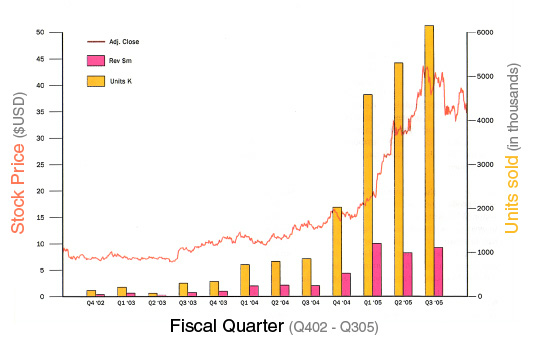Design that Moves Business: Apple’s “Overnight” Success! (Part 1)
When has design moved business? Design and business folks love the example of the iPod. Designers say, look at how one design-driven product was able to reshape an entire industry. MBAs emphasize how the strategy behind the iPod-iTunes system and the product roadmap led to Apple’s success. We all tend to point to the iPod design the way a high school basketball player points to Michael Jordan. Yet contrary to popular belief, Apple’s iPod was neither a single ingenious invention nor an overnight success. The iPod was not the first MP3 player on the market and it may not even be the “best” one out there. But regardless of subjective opinion on how good it is, the iPod is clearly a success, as reflected in the ramp up of Apple’s sales and stock price (shown in Example 1). Apple found a formula to grab customers and got their customers to grab right back. In this case they grabbed enough for Apple to become the indisputable market leader, capturing over 70% of the MP3 player market in units sold.

(Example 1 – Growth of Apple stock, iPod unit sales and revenues)
Apple seems to be a prime example of a successful design-driven business.
But hold on. What does a design-driven business look like? And do you even want business to be driven by design?
We’ve been working in the space between design and business for a while now and have formed quite a few opinions on this. We believe that “design-driven” means taking a holistic approach, where design methods help to guide business strategy as well as shape the product, service and process development.
This means that from day one, a company like Apple must understand how to meet the user’s needs and aspirations. Understanding them, however, is not enough: any company serious about a design-driven process must make them as much of a priority as the revenue models behind the product.
This also means that such companies need to apply the same brainstorming techniques used in design to create new models for distribution, revenue streams and maintenance. For Apple, this resulted in ideas like the Apple store, iTunes and the Genius Bar.
Sources:
Example 1 chart is from Bill Buxton’s book, Sketching User Experience: getting the design right and the right design. All rights reserved.
This segment is part 1 in the series : Design that Moves Business: Apple’s “Overnight” Success!
1 2 3
Featured Videos
Can 1M/1M Help Me Raise Money?
How Does 1M/1M Democratize Entrepreneurship Education?
How Does 1M/1M Democratize Management Consulting?
When Is The Right Time To Join 1M/1M?
Can 1M/1M Help Me With Business Development?
Can 1M/1M Help Me With Market Sizing?
Can 1M/1M Help Me Validate My Product?
Will I Have Private 1-on-1 Sessions In 1M/1M?
How Does 1M/1M Help Entrepreneurs Connect With Silicon Valley?
Mentoring or Consulting?
Why Does 1M/1M Charge $1000 a Year?
Why Does 1M/1M Partner With Local Organizations?
Why Don\’t Mentoring Networks Work?
Why Is It Important To Study With 1M/1M Now?
Dan Stewart Story
Vikrant Mathur Story
